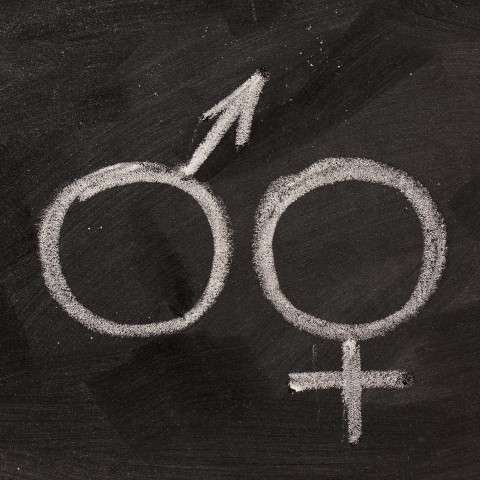Many foreigners throughout the years have gotten high praise for speaking “correct” Arabic.
And many others have spoken “broken” Arabic.
Obviously, there are a lot of things that could go into that distinction, but one of the most important is grammatical gender. If you get those word endings wrong on nouns, adjectives, and verbs, you’ll still be understood—but it’ll sound strange.
That’s not a word you want to associate with your Arabic level!
If you’re not yet comfortable with word gender in Arabic, don’t worry. Simply read on, and let the knowledge come to you.
- What is Grammatical Gender?
- The Arabic Noun Gender System: See a Word, Guess its Gender
- Gender in Arabic Pronouns and Verbs
- Plural Nouns
- Noun Gender Plus Adjectives
- Memorizing Gender from the Beginning
- Conclusion
1. What is Grammatical Gender?
First, let’s solve a quick problem of nomenclature. Quit thinking of this “gender” as it relates to the English word “gender.” Instead, think of it more like a “category.”
Noun gender is just a secondary feature of a noun that determines which form other adjectives or articles need to take. Some nouns in some categories have adjectives with X ending, and some with Y ending.
Most languages with grammatical gender have just two, called “masculine” and “feminine.” Some languages have a third one, called “neuter” or sometimes “common.” Some languages have quite a few more!
In the European linguistic tradition, we have a habit of calling these categories “genders” because they usually line up with living beings of different genders.
For example, the word for “boy” has a masculine grammatical gender, while the word for “girl” has a female gender. Other words are up in the air. There’s usually no consistency between languages as to what inanimate objects will be masculine or feminine.
In Arabic, there are two grammatical genders, and every noun has one. And there’s good news and bad news here. Most Arabic words have a clearly-guessable gender, with certain verb endings that we’ll talk about in a moment. However, there are a lot of exceptions. There are masculine-looking nouns that take feminine adjectives, and there are feminine-looking nouns that take masculine adjectives. There are even unmarked nouns that simply must be memorized. But don’t worry—we’ll talk about that later, too.
2. The Arabic Noun Gender System: See a Word, Guess its Gender
So, how do you know if a word is masculine or feminine in Arabic?
In Arabic, the masculine form is the “unmarked” form. That means there’s no special ending.
Therefore, it’s the feminine form that’s “marked.” That is, it has an ending. By far, the most common ending is ة. This letter is called taa marbuuta, and it only appears at the end of a word. It’s always preceded by fatha, so feminine nouns generally end in -a.
This is what’s called a “productive suffix,” meaning that you can add it to words and generate a new word that people will accept as correct. That’s how we get the feminine forms of different occupations. For instance:
president (male)
رَئيس
raʾīs
president (female)
رَئيسَة
raʾīsah
scientist (male)
عالِم
ʿalim
scientist (female)
عالِمَة
ʿal-imah
Some more endings are ʾalif maqsūrah and ʾalif hamzah. But watch out—some of the words ending with these two forms don’t have a predictable gender.
desert
صَحراء
Ṣaḥrāʾ
hospital
مُستَشفى
mustašfā
Lastly, there are some words that are accepted as either feminine or masculine. Here are three relatively common ones:
road
طَريق
ṭarīq
souq
سوق
sūq
knife
سِكّين
sikkīn
Was that really so hard? Unfortunately, now we’ll look at some exceptions to these Arabic gender rules.
First, there are a handful of names with feminine endings that are actually masculine. Muawiya and Talha are two male figures from the Quran whose names end in taa marbuuta. But such names aren’t popular anymore.
There are also some mass nouns in Arabic that use the taa marbuuta to signify just one of that thing. For example, the words “ants” and “trees” are usually referred to in the plural, but to refer to just one ant or one tree, we can use the taa marbuuta to make it a singular (masculine) noun.
Trees give the world oxygen and shade.
الأَشجار تُعطي العالَم الأوكيسيجين والظِل.
al-ʾašǧār tuʿṭī al-ʿalam al-ʾūkīsīǧīn ūlẓil.
The floor is covered in ants.
الأَرضِيَّة مَليئَة بِالنَمل.
al-ʾarḍiyyah malīʾah bilnaml.
The ant slowly climbs up the tree.
النَملَة تَتَسَلَّق الشَجَرَة بِبُطء.
al-namlah tatasallaq al-šaǧarah bibuṭʾ.
3. Gender in Arabic Pronouns and Verbs
Let’s take a brief detour from nouns to talk about gender in other parts of Arabic, namely the pronoun system and the verb system.
Some languages have just one third-person gender, covering “he,” “she,” and “it.” English, of course, has three, for masculine, feminine, and neuter. Arabic has the same, but Arabic speakers also distinguish that for the second person, that is, “you.”
Where are you? (to a man)
مِن أَيْنَ أَنتَ؟
min ʾayna ʾanta?
Where are you? (to a woman)
مِن أَيْنَ أَنتِ؟
min ʾayna ʾanti?
There’s also a distinction made for the plural form, both in the equivalents of “you all” and “they.”
Are you all alright? (to several women)
هَل أَنتُنَّ بِخَيْر؟
hal ʾantunna biḫayr?
Are you all alright? (to several men)
هَل أََنتُم بِخَيْر؟
hal ʾantum biḫayr?
These example sentences are a little unwieldy, so we won’t write out all the differences here. Instead, there are plenty of great charts and grammar lessons online!
You may have heard of Arabic verbs also being inflected for gender in some way. That’s sort of true, but it’s not as bad as you might have thought.
Object pronouns (“him,” “her,” “me,” “them” ) just get attached to the verb instead of staying as separate words. So you could think of verbs as just linking up with a gendered pronoun, not having a complex gender system of their own.
I am helping Anna.
أَنا أُساعِد آنا.
ʾanā ʾusāʿid ʾānā.
I am helping her.
أَنا أُساعِدُها.
ʾanā ʾusāʿiduhā.
Again, this is something that deserves an article of its own, but we included it here to show you how word gender across all of Arabic simply works differently than in English. It’s not only the nouns!
4. Plural Nouns
The most important overarching concept to remember with Arabic plurals is that non-human nouns in the plural are treated as singular feminine nouns. If you happen to know any German, it’s a similar concept.
Take a look at the following sentences.
The new (female) teacher is eating.
الأُستاذَة الجَديدَة تَأكُل.
al-ʾustāḏah al-ǧadīdah taʾkul.
This city has new streets.
لَدى المَدينة شَوَارِع جَديدَة.
ladā al-madīnh šawariʿ ǧadīdah.
David has four new cars.
لَدى داوُود أَربَع سَيّارات جَديدَة.
ladā dāwūd ʾarbaʿ sayyārāt ǧadīdah.
Here, the adjective for “new” stayed the same, even though we first talked about one female teacher, then many new streets, then four new cars.
5. Noun Gender Plus Adjectives
Adjectives in Arabic have to match their nouns. This is commonly known as “agreement,” so if there’s a mistake in your adjective endings, you can say that they’re not agreeing.
To get them to cooperate with each other, we have to make sure that we match feminine nouns with feminine adjectives.
Fortunately, this is simple in principle. Just as we added the taa marbuuta to some masculine job occupations to get the feminine form, we’ll add the taa marbuuta to adjectives in order to modify feminine nouns.
The brown cat is walking.
القِطَّة البُنِّيَّة تَمشي.
al-qiṭṭah al-bunniyyah tamšī.
The brown mouse is walking.
الفَأر البُنّيُّ يَمشي.
al-faʾr al-bunniyyu yamšī.
Since “cat” is feminine and “mouse” is masculine, the word for “brown” has to change.
Naturally, we can’t just have one adjective agree and the rest disagree. What happens when we include two adjectives?
My uncle is a short and funny man.
عَمّي/خالي رَجُل قَصير و مُضحِك.
ʿammī/ḫal-ī raǧul qaṣīr wa muḍḥik.
My aunt is a short and funny woman.
عَمَّتي/خالَتي إمرَأَة قَصيرَة و مُضحِكَة.
ʿammatī/ḫal-atī ʾimraʾah qaṣīrah wa muḍḥikah.
Same sentence structure, different adjective forms.
There are many adjectives that follow slightly different rules for noun gender, and some that don’t change at all. For example, the words “sick” and “tolerant” don’t change.
When I first saw him, he was an old and sick man.
عِندَما رَأَيْتُهُ لِأَوَّلِ مَرَّة, كانَ رَجُلاً مُسِنّاً و مَريضاً.
ʿindamā raʾaytuhu liʾawwali marrah, kāna raǧulan musinnan wa marīḍan.
Have you talked to the sick woman in room 7?
هَل تَحَدَّثتَ إلى اللمَرأَة المَريضَة في غُرفَة رَقَم سبِعة؟
hal taḥaddaṯta ʾilā al-lmarʾah al-marīḍah fī ġurfah raqam sbiʿh?
It is good to have tolerant (female) teachers.
مِن الجَميلِ أَن يَكونَ لَدَيْكَ أُستاذَة مُتَسامِحَة.
min al-ǧamīli ʾan yakūna ladayka ʾustāḏah mutasāmiḥah.
Jacques is a tolerant man.
جاك رَجُلٌ مُتَسامِح.
ǧāk raǧulun mutasāmiḥ.
6. Memorizing Gender from the Beginning
Research shows that Arabic learners in particular have a hard time with getting perfectly accurate word gender, even if the learners have spent years in Arabic-speaking countries.
And if you happen to come from a European background, no luck there either—there’s no benefit from being a native speaker of another language with grammatical gender!
That particular study revealed that even advanced learners have “incomplete” models of grammatical gender in their minds, where they may know all the rules but fail to apply them correctly.
So here are a couple of different techniques you can use to train yourself to remember the Arabic word gender as often as possible!
First, you can use memory tricks. Some people are really great at visualizing things in their mind’s eye, and those people will probably prefer this method.
Imagine the word حرب (harb) meaning “war.” Although it doesn’t end with taa marbuuta, it’s a feminine word which takes feminine adjectives:
That was a long and terrible war.
لقد كانَت حَرباً طَوِيلَة و رَهيبَة.
laqad kānat ḥarban ṭawilah wa rahībah.
One memory trick is to imagine a room full of women generals, with coats covered in medals of valor.
Take a moment to look around that boardroom in your mind’s eye—is it open and well-lit or are the generals hunched over war plans on a table? Fix that image in your head, and you’ll think of it whenever you need to say “war” in Arabic (which hopefully won’t be too often!).
Since you probably can’t forget that one if you tried, let’s think of another mnemonic for another irregular Arabic word.
The word راديو (radiu) is a loanword meaning “radio.” Like many loanwords about technology, راديو is masculine.
I don’t need that old radio.
لا أَحتاجُ إلى ذَلِكَ الراديُو القَديم.
lā ʾaḥtāǧu ʾilā ḏalika al-rādyuū al-qadīm.
Other methods that people use include writing masculine and feminine words in different-colored ink in a notebook. This may get tedious, though, because as you know, most Arabic words are regular.
One of the most effective ways to learn to produce Arabic word gender correctly in fluent speech is to simply practice set phrases that are likely to come up.
Look at your own writing or listen critically to a recording you make of yourself. Then write down some of the words you’re having trouble with, and come up with some example sentences where you’d like to use it.
Practice those set phrases aloud, even recording your own voice again to listen back. This will really help stick those patterns into your memory, and because they’re tailored for you, your exercises will be extremely efficient.
7. Conclusion
In addition to those targeted noun and adjective exercises, sometimes the best way to learn a language is simply through exposure. That means native Arabic materials, whether it be TV soap operas, audiobooks, or even podcasts. You can also check out our video about gender in Arabic.
Here at ArabicPod101, you have access to some of the best Arabic learning material on the internet for all levels, including study guides and vocabulary lists.
With all of these tools right at your fingertips, you’ll never fail. Start speaking excellent Arabic today!
Before you go, let us know in the comments how comfortable you feel about Arabic word gender so far. Practice will help you get better, but feel free to let us know if you have any questions or concerns. We look forward to hearing from you!
















